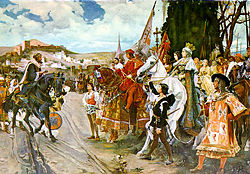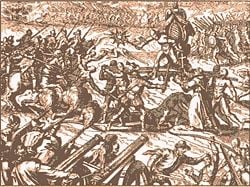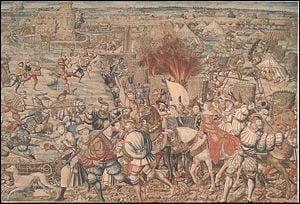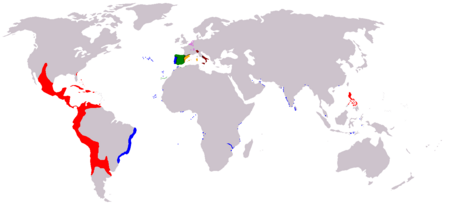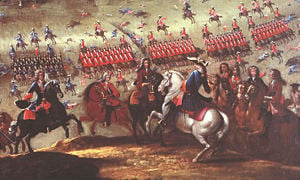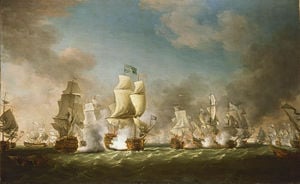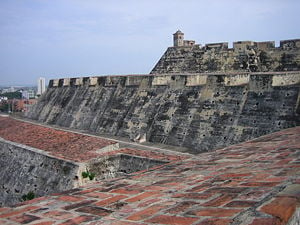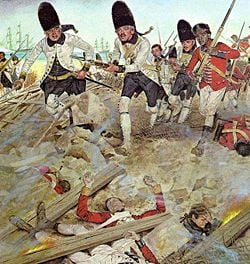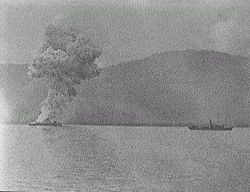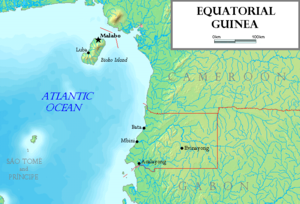Spanish Empire
Spain led European global exploration and colonial expansion in the fifteenth and sixteenth centuries. Trade flourished across the Atlantic and Pacific Oceans. Toppling the Aztec and Inca civilizations, Spain laid claim to vast territories in North and South America. The Spanish Empire became the foremost global power, dominating the oceans as well as European battlefields. Spain enjoyed a cultural golden age in the sixteenth and seventeenth centuries when silver and gold from American mines increasingly financed a long series of European and North African wars. Until the eighteenth century, the Spanish empire was the largest in the world, although it suffered fluctuating military and economic fortunes. Confronted by the new experiences, difficulties and suffering created by empire-building, Spanish thinkers formulated some of the first modern ideas on natural law, sovereignty, international law, war, and economics—even questioning the legitimacy of imperialism.
The Peace of Utrecht (1713) stripped Spain of its remaining territories in the Italian Peninsula, Sicily and the Low Countries. However, Spain maintained, and even enlarged, its vast American empire until the early nineteenth century, and maintained its Asia-Pacific territories until 1898. Spanish participation in the Scramble for Africa was negligible: Spanish Morocco was held until 1956 and Spanish Guinea and the Spanish Sahara were held until 1968 and 1975 respectively. The Canary Islands, Ceuta, Melilla are administrative divisions that have remained part of Spain and, Isla de Alborán, Isla Perejil, Islas Chafarinas, Peñón de Alhucemas, and Peñón de Vélez de la Gomera are territories which have remained part of Spain. Also, according to the United Nations "Spanish Sahara/Western Sahara," annexed by Morocco in 1976, is still technically under Spanish Administration. On the one hand, the Spanish empire was often exploitative and culturally destructive. On the other hand, it also did much to create cultural and linguistic links across the globe, helping to nurture consciousness that in the end all humans occupy a single planetary home, which, if not kept healthy and sustainable, will become our common grave. Spanish explores and explorers in her service helped humanity realize that the world is one by mapping and charting its seas and continents.
The Origins of the Empire (1402–1521)
During the last 250 years of the Reconquista era, the Castilian monarchy, tolerated the small Moorish taifa client-kingdom of Granada in the south-east by exacting tributes of gold, the parias, and, in so doing, ensuring that gold from the Niger region of Africa entered Europe. Castile also intervened in Northern Africa itself, competing with the Portuguese Empire, when Henry III of Castile began the colonization of the Canary Islands in 1402, authorizing under feudal agreement to Norman noblemen Jean de Béthencourt. The conquest of Canary Islands, inhabited by Guanche people, was only finished when the own armies of the Crown of Castille won in long and bloody wars, the islands of Gran Canaria (1478-1483), La Palma (1492-1493) and Tenerife (1494-1496).
The marriage of the Ferdinand II of Aragon and Isabella I of Castile created a confederation of reigns, each with their own administrations, but ruled by a common monarchy. According to Henry Kamen, Spain was created by the Empire, rather than the Empire being created by Spain.
In 1492, Spain drove out the last Moorish king of Granada. After their victory, the Spanish monarchs negotiated with Christopher Columbus, a Genoese sailor attempting to reach Cipangu by sailing west. Castile was already engaged in a race of exploration with Portugal to reach the Far East by sea when Columbus made his bold proposal to Isabella. Columbus instead "inadvertently" discovered America, inaugurating the Spanish colonization of the continent. The Indies were reserved for Castile.
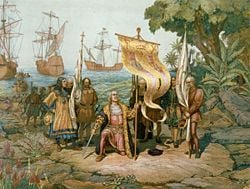
The claim of Spain to these lands was solidified by the Inter caetera papal bull of 1493, and by the immediately following Treaty of Tordesillas of 1494, in which the globe was divided into two hemispheres between Spanish and Portuguese claims. These actions gave Spain exclusive rights to establish colonies in all of the New World from Alaska to Cape Horn (except Brazil), as well as the easternmost parts of Asia. The Castilian Empire was the result of a period of rapid colonial expansion into the New World, as well as the Philippines and colonies in Africa: Melilla was captured by Castile in 1497 and Oran in 1509.
The Catholic Monarchs decided to support the Aragonese house of Naples against Charles VIII of France in the Italian Wars from 1494. As king of Aragon, Ferdinand had been involved in the struggle against France and Venice for control of Italy; these conflicts became the center of Ferdinand's foreign policy as king. In these battles, which established the supremacy of the Spanish infantry against French knights, Gonzalo Fernández de Córdoba would forge the nearly invincible Spanish army of the sixteenth and early seventeenth centuries.
After the death of Queen Isabella, Ferdinand as Spain's sole monarch adopted a more aggressive policy than he had as Isabella's husband, enlarging Spain's sphere of influence in Italy and against France. Ferdinand's first investment of Spanish forces came in the War of the League of Cambrai against Venice, where the Spanish soldiers distinguished themselves on the field alongside their French allies at the Battle of Agnadello (1509). Only a year later, Ferdinand became part of the Holy League against France, seeing a chance at taking both Milan—to which he held a dynastic claim—and Navarre. The war was less of a success than that against Venice, and in 1516, France agreed to a truce that left Milan in her control and recognized Spanish control of Upper Navarre.
Upon the settlement of Hispanola which was successful in the early 1500s, the colonists began searching elsewhere to begin new settlements. Those from the less prosperous Hispaniola were eager to search for new success in a new settlement. From there Juan Ponce de León conquered Puerto Rico and Diego Velázquez took Cuba. The first settlement on the mainland was Darién in Panama, settled by Vasco Núñez de Balboa in 1512.
In 1513, Balboa crossed the Isthmus of Panama, and led the first European expedition to see the Pacific Ocean from the west coast of the New World. In an action with enduring historical import, Balboa claimed the Pacific Ocean and all the lands adjoining it for the Spanish Crown.
The coastal villages and towns of Spain, Italy and Mediterranean islands were frequently attacked by Barbary pirates from North Africa, the Formentera was even temporarily left by its population and long stretches of the Spanish and Italian coasts were almost completely abandoned by their inhabitants. The most famous corsair was the Turkish Barbarossa ("Redbeard"). According to Robert Davis between 1 million and 1.25 million Europeans were captured by North African pirates and sold as slaves in North Africa and Ottoman Empire between the sixteenth and nineteenth centuries.[1]
The Sun Never Sets (1521–1643)
The sixteenth and seventeenth centuries are sometimes called "the Golden Age of Spain" (in Spanish. As a result of the marriage politics of the Reyes Católicos, their grandson Charles inherited the Castilian empire in America, the Aragonese Empire in the Mediterranean (including a large portion of modern Italy), as well as the crown of the Holy Roman Empire and of the Low Countries and Franche-Comté. Thus this Empire was constituted from the inheritance of territories, and not through conquest. After his defeat of the Castilian rebels in the Castilian War of the Communities, Charles became the most powerful man in Europe, his rule stretching over an empire in Europe unrivalled in extent until the Napoleonic era. It was often said during this time that it was the empire on which the sun never set. This sprawling empire of the Spanish Golden Age was controlled, not from distant inland Madrid, but from Seville.
Commercially this Castilian Empire abroad was initially a disappointment. It did stimulate some trade and industry. In the 1520s the large scale extraction of silver from the rich deposits of Mexico's Guanajuato began, but it was not until the opening of the silver mines in Mexico's Zacatecas and Peru's Potosi in 1546 that the large shipments of silver became the fabled source of wealth. During the sixteenth century, Spain held the equivalent of US$1.5 trillion (1990 terms) in gold and silver received from New Spain. Ultimately, however, these imports diverted investment away from other forms industry and contributed to inflation in Spain in the last decades of the sixteenth century. This situation was aggravated (but nothing like as much as popular myth asserts) by the loss of many from the commercial and artisan classes with the expulsions of the Jews and Moriscos. The vast imports of silver ultimately made Spain overly dependent on foreign sources of raw materials and manufactured goods.
The wealthy preferred to invest their fortunes in public debt (juros), which were backed by these silver imports, rather than in production of manufactures and the improvement of agriculture. This helped perpetuate the medieval aristocratic prejudice that saw manual work as dishonorable long after this attitude had started to decline in other west European countries. The silver and gold whose circulation helped facilitate the economic and social revolutions taking place in the Low Countries, France and England and other parts of Europe helped stifle them in Spain. The problems caused by inflation were discussed by scholars at the School of Salamanca and arbitristas but they had no impact on the Habsburg government.
The Habsburg dynasty squandered the American and Castilian riches in wars across Europe for Habsburg interests, defaulted on their debt several times, and left Spain bankrupt (with the tensions between the Empire and the people of Castile exploding in the popular rebellion of the Castilian War of the Communities (1520–1522). The Habsburg political goals were several:
- Access to American (gold, silver, sugar) and Asian products (porcelain, spices, silk)
- Undermining the power of France and containing it in its eastern borders.
- Maintaining Catholic Habsburg hegemony in Germany, defending Catholicism against the Reformation. Charles attempted to quell the Protestant Reformation at the Diet of Worms but Luther refused to recant his heresy. However, Charles's piety could not stop his mutinying troops from plundering the Holy See in the Sacco di Roma.
- Defending Europe against Islam, notably the Ottoman Empire.
Siege of Tenochtitlan, conquest of the Inca Empire and the discovery of the Philippines (1519–1541)
After Columbus, the colonization of America was led by a series of warrior-explorers called the Conquistadors. The Spanish forces exploited the rivalries between competing local peoples and states, some of which were only too willing to form alliances with the Spanish in order to defeat their more-powerful enemies, such as the Aztecs or Incas - a tactic that later European colonial powers would use extensively. The spread of diseases (e.g. smallpox) common in Europe but unknown in the New World, which decimated the native American populations also aided the Spanish conquest.[2] This caused a labor shortage, so the colonists initiated the Atlantic slave trade.
The Laws of Burgos, 1512-1513 were the first codified set of laws governing the behavior of Spanish settlers in America, particularly with regards to native Indians. They forbade the maltreatment of natives, and endorsed their conversion to Catholicism.[3]
One of the most successful conquistadors was Hernán Cortés. With a relatively small Spanish force but also supported by around two hundred thousand Amerindian allies, he overran the Aztec empire in the campaigns of 1519–1521, bringing Mexico under Spanish rule as the colony of New Spain. Francisco Pizarro's conquest of the Inca empire was equally important. This became the Viceroyalty of Peru. After Mexico's conquest, rumors of golden cities (Quivira and Cíbola in North America, El Dorado in South America) caused several more expeditions to be sent out. Many of those returned without having found their goal, or having found it, finding it much less valuable than was hoped. The American colonies only began to yield a substantial part of the crown's revenues after the establishment of mines such as Potosí (1546). By the late sixteenth century American silver accounted for one-fifth of Spain's total budget. In the sixteenth century perhaps 240,000 Europeans entered American ports.[4]
The Portuguese Ferdinand Magellan died while in the Philippines commanding a Castilian expedition to circumnavigate the globe in 1522. Juan Sebastián Elcano led the expedition to success.
Meanwhile, in Europe, Francis I of France found himself surrounded by Habsburg territories, invaded the Spanish possessions in Italy in 1521, inaugurating a second round of Franco-Spanish conflict. The war was a disaster for France, which suffered defeat at Biccoca (1522), Pavia (1525, at which Francis was captured), and Landriano (1529) before Francis relented and abandoned Milan to Spain once more.
Charles's victory at the Battle of Pavia, 1525, surprised many Italians and Germans, eliciting concerns that Charles would try to gain ever greater power. Switching sides, Pope Clement VII joined forces with France and prominent Italian states against the Habsburg Emperor in the War of the League of Cognac. In 1527, Charles, exhausted with the pope's meddling in what he viewed as purely secular affairs, and sacked Rome, embarrassing the papacy sufficiently enough that Clement, and succeeding popes, were considerably more circumspect in their dealings with secular authorities. In 1533, Clement's refusal to annul Henry VIII of England's marriage was a direct consequence of his unwillingness to offend the emperor. The Peace of Barcelona, signed between Charles and the Pope in 1529, established a more cordial relationship between the two leaders. Spain was effectively named the protector of the Catholic cause and Charles was crowned as King of Italy (Lombardy) in return for Spanish intervention in overthrowing the rebellious Florentine Republic.
In 1528, admiral Andrea Doria allied with the Emperor to oust the French and restore Genoa's independence, opening the prospect for financial renewal: 1528 marks the first loan from Genoese banks to Charles.
Further Spanish settlements were progressively established in the New World: New Granada (modern Colombia) in the 1530s, Lima in 1535 the capital of the Viceroyalty of Peru, Buenos Aires in 1536 and Santiago in 1541.
New Laws to the Peace of Augsburg (1542–1555)
Spain passed some laws for the protection of the indigenous peoples of its American colonies, the first such in 1542; the legal thought behind them was the basis of modern international law. Taking advantage of their extreme remoteness, the European colonists revolted when they saw their power being reduced, forcing a partial revoking of these New Laws. Later, weaker laws were introduced to protect indigenous peoples but records show their effect was limited. The restored Encomenderos increasingly used native Indian workforce.
In 1543, the king of France Francis I announced his unprecedented alliance with the Ottoman sultan, Suleiman the Magnificent, by occupying the Spanish-controlled city of Nice in concert with Ottoman forces.[5] Henry VIII of England, who bore a greater grudge against France than he held against the Emperor for standing in the way of his divorce, joined Charles in his invasion of France. Although the Spanish army was defeated at the Battle of Ceresole in Savoy the French were unable to seriously threaten Spanish controlled Milan, whilst suffering defeat in the north at the hands of Henry, thereby being forced to accept unfavorable terms. The Austrians, led by Charles's younger brother Ferdinand, continued to fight the Ottomans in the east. Charles went to take care of an older problem: the Schmalkaldic League.
The League was allied with the French, and efforts in Germany to undermine it had been rebuffed. Francis's defeat in 1544 led to the annulment of the alliance with the Protestants, and Charles took advantage of the opportunity. He first tried the path of negotiation at the Council of Trent in 1545. However, the Protestant leadership, feeling betrayed by the stance taken by the Catholics at the council, went to war led by the Saxon elector Maurice. In response, Charles invaded Germany at the head of a mixed Dutch–Spanish army, hoping to restore Imperial authority. The emperor personally inflicted a decisive defeat on the Protestants at the Battle of Mühlberg in 1547. In 1555, Charles signed the Peace of Augsburg with the Protestant states, restoring stability in Germany on his principle of cuius regio, eius religio[6], a position unpopular with Spanish and Italian clergymen. Charles's involvement in Germany established a role for Spain as protector of the Catholic, Habsburg cause in the Holy Roman Empire; the precedent led, seven decades later, to a war that ended Spain's role as Europe's leading power.
Charles preferred to suppress the Ottomans through a more maritime strategy, hampering Ottoman movements in the Eastern Mediterranean. Only in response to Barbary pirate’s raids on the eastern coast of Spain did Charles personally lead attacks against the Algiers (1541).[7]
St. Quentin to Lepanto (1556–1571)
Charles V's only legitimate son, Philip II of Spain (r. 1556–1598) parted the Austrian possessions with his uncle Ferdinand. Philip treated Castile as the foundation of his empire, but the population of Castile (about a third of France's) was never large enough to provide the soldiers needed to support the Empire. His marriage to Mary Tudor allied England with Spain.
Spain was not yet at peace when the aggressive Henry II of France came to the throne in 1547, who immediately renewed conflict with Spain. Charles's successor, Philip II, pursued the war against France, crushing a French army at the Battle of St. Quentin in Picardy in 1558 and defeating Henry again at the Battle of Gravelines. The Peace of Cateau-Cambrésis, signed in 1559, permanently recognized Spanish claims in Italy. In the celebrations following the treaty, Henry was killed by a stray splinter from a lance. For the next thirty years, France, preoccupied with chronic civil war, was effectively removed from competing with Spain and the Habsburg family in European power games. Freed from French opposition, Spain reached the zenith of its might and territorial reach in the period 1559–1643.
The opening for the Genoese banking consortium was the state bankruptcy of Philip II in 1557, which threw the German banking houses into chaos and ended the reign of the Fuggers as Spanish financiers.[8] The Genoese bankers provided the unwieldy Habsburg system with fluid credit and a dependably regular income. In return the less dependable shipments of American silver were rapidly transferred from Seville to Genoa, to provide capital for further ventures.
Florida was colonized in 1565 by Pedro Menéndez de Avilés when he founded Saint Augustine, Florida and then defeated an attempt led by the French Captain Jean Ribault and 150 of his countrymen to establish a French foothold in Spanish Florida territory. Saint Augustine became a strategic defensive base for Spanish ships full of gold and silver sailing to Spain. On April 27, 1565, Miguel López de Legazpi founded the first permanent Spanish settlement in the Philippines and started the service of Manilla Galleons. Manilla Galleons shipped goods from Asia across the Pacific to Acapulco on the coast of Mexico. From there, the goods were transported across Mexico to the Spanish treasure fleets, for shipment to Spain. The Spanish trading post of Manila was established to facilitate this trade in 1572. The Philippines, the Pacific islands of Guam, the Mariana Islands, and the Caroline Islands remained under Spanish control until the Spanish American War, 1898.

After Spain's victory over France and the beginning of France's religious wars, Philip II's ambitions grew. In 1565, the Spanish defeated an Ottoman landing on the strategic island of Malta, defended by the Knights of St. John. Suleiman the Magnificent's died the following year. Succession by his less capable son Selim the Sot emboldened Philip to carry the war to the sultan himself. In 1571, Charles's illegitimate son Don John of Austria led Spanish and Venetian warships, joined by volunteers across Europe who annihilated the Ottoman fleet at the Battle of Lepanto, one of the most decisive battles in naval history. The battle ended the threat of Ottoman naval power in the Mediterranean and enhanced Spain's status in Europe.
European Conflicts (1571–1598)
The time for rejoicing in Madrid was short-lived. In 1566, Calvinist-led riots in the Netherlands prompted the Duke of Alva to march into the country in an effort to restore order. In 1568, William of Orange, better known as William the Silent, led a failed attempt to drive Alva from the Netherlands. These battles are considered to signal the start of the Eighty Years' War that led to the independence of the United Provinces. The Spanish, who derived a great deal of wealth from the Netherlands, especially from the port of Antwerp, were committed to restoring order and their hold over the provinces. In 1572, a band of rebel Dutch privateers known as the watergeuzen ("Sea Beggars") seized a number of Dutch coastal towns, proclaimed their support for William and denounced the Spanish leadership.

For Spain, the war became an endless quagmire, sometimes literally. In 1574, the Spanish army under Luis de Requeséns was repulsed from the Siege of Leiden after the Dutch broke the dykes, causing extensive flooding. In 1576, faced with the bills from his 80,000-man army of occupation in the Netherlands, the cost of his fleet that had won at Lepanto, together with the growing threat of piracy in the open seas reducing his income from his American colonies Philip was forced to accept bankruptcy. Soon after, the army in the Netherlands mutinied; seizing Antwerp, they looted southern Netherlands, prompting several cities in the previously peaceful southern provinces to join the rebellion. Choosing negotiation, the Spanish pacified most of the southern provinces with the 1579 Union of Arras. In response, the Netherlands created the Union of Utrecht, as an alliance between the northern provinces. They officially deposed Philip in 1581 when they signed the Oath of Abjuration.
Under the Arras agreement the southern states of the Spanish Netherlands, today in Wallonia and the Nord-Pas-de-Calais (and Picardy) régions in France, expressed their loyalty to the Spanish king Philip II, recognizing his Governor-General, Don Juan of Austria. In 1580, King Philip seized the opportunity to strengthen his position when the last member of the Portuguese royal family, Cardinal Henry of Portugal, died and he asserted his claim to the Portuguese throne. In June, he sent the Duke of Alba with an army to Lisbon to assure his succession. Although the Duke of Alba and the Spanish occupation was little more popular in Lisbon than in Rotterdam, the combined Spanish and Portuguese empires placed into Philip's hands almost all the explored New World, along with a vast trading empire in Africa and Asia. In 1582, when Philip II moved his court back to Madrid from the Atlantic port of Lisbon where he had temporarily settled to pacify his new Portuguese kingdom, the pattern was sealed, in spite of what every observant commentator privately noted: "Sea power is more important to the ruler of Spain than any other prince" wrote a commentator, "for it is only by sea power that a single community can be created out of so many so far apart." A writer on tactics in 1638 observed, "The might most suited to the arms of Spain is that which is placed on the seas, but this matter of state is so well known that I should not discuss it, even if I thought it opportune to do so."[9]
Portugal required an extensive occupation force to keep it under control, and Spain was still reeling from the 1576 bankruptcy. In 1584, a half-deranged Catholic assassinated William the Silent. It was hoped that his death would bring an end to the war. It did not. In 1586, Queen Elizabeth I of England, sent support to the Protestant causes in the Netherlands and France, and Sir Francis Drake launched attacks against Spanish merchants in the Caribbean and the Pacific, along with a particularly aggressive attack on the port of Cadiz. In 1588, planning to put a stop to Elizabeth’s meddling, Philip sent the Spanish Armada to attack England. Favorable weather, smaller, more maneuverable English ships, and the fact that England had been warned by their spies in the Netherlands and were ready for the attack resulted in defeat for the outnumbered but more heavily armored Spanish fleet. Nevertheless the defeat of the military attack, The Drake–Norris Expedition, 1589 marked a turning point in the 1585–1604 Anglo–Spanish War in Spain's favor, and few can doubt that the Spanish fleet was the strongest in Europe until the Dutch fleet inflicted defeat at the Battle of the Downs in 1639, when an increasingly exhausted Spain began to visibly weaken.
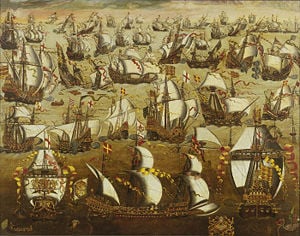
Henry II’s death, Spain invested itself in the religious warfare in France. In 1589, Henry III, the last of the Valois lineage, died at the walls of Paris. His successor, Henry IV of Navarre, the first Bourbon king of France, was a man of great ability, winning key victories against the Catholic League at Arques (1589) and Ivry (1590). Committed to stopping Henry of Navarre from becoming King of France, the Spanish divided their army in the Netherlands and invaded France in 1590.
"God is Spanish" (1596–1626)
Faced with wars against England, France and the Netherlands, each led by capable leaders, the bankrupted empire found itself competing against strong adversaries. Continuing piracy against its shipping in the Atlantic and the costly colonial enterprises forced Spain to renegotiate its debts in 1596. The plague devastated Castilian lands between 1596 and 1602, causing the deaths of 500,000 people.[10] The crown attempted to reduce its exposure to the different conflicts, first signing the Treaty of Vervins with France in 1598, recognizing Henry IV (since 1593 a Catholic) as king of France, and restoring many of the stipulations of the previous Peace of Cateau-Cambrésis. England, suffering from a series of defeats at sea and from an endless guerrilla war by Catholics in Ireland, who were supported by Spain, agreed to the Treaty of London, 1604, following the accession of the more tractable Stuart King James I.
Peace with England and France gave Spain an opportunity to focus her energies on restoring her rule over the Dutch. The Dutch, led by Maurice of Nassau, the son of William the Silent and perhaps the greatest strategist of his time, had succeeded in taking a number of border cities since 1590, including the fortress of Breda. Following the peace with England, the new Spanish commander Ambrogio Spinola, a general with the ability to match Maurice, pressed hard against the Dutch and was prevented from conquering the Netherlands only by Spain's latest bankruptcy in 1607. In 1609, the Twelve Years' Truce was signed between Spain and the United Provinces. At last, Spain was at peace - the Pax Hispanica.
Spain made a fair recovery during the truce, putting her finances in order and doing much to restore her prestige and stability in the run-up to the last truly great war in which she would play a leading part. Philip II's successor, Philip III, was a man of limited ability, uninterested in politics and preferring to delegate management of the empire to others. His chief minister was the capable Duke of Lerma.
The Duke of Lerma (and to a large extent Philip II) had been uninterested in the affairs of their ally, Austria. In 1618, the king replaced him with Don Balthasar de Zúñiga, a veteran ambassador to Vienna. Don Balthasar believed that the key to restraining the resurgent French and eliminating the Dutch was a closer alliance with Habsburg Austria. In 1618, beginning with the Defenestration of Prague, Austria and the Holy Roman Emperor, Ferdinand II, embarked on a campaign against the Protestant Union and Bohemia. Don Balthasar encouraged Philip to join the Austrian Habsburgs in the war, and Spinola, the rising star of the Spanish army in the Netherlands, was sent at the head of the Army of Flanders to intervene. Thus, Spain entered into the Thirty Years' War.
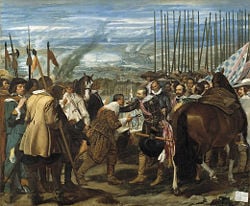
In 1621, Philip III was succeeded by the considerably more religious Philip IV. The following year, Don Balthasar was replaced by Gaspar de Guzman, Count-Duke of Olivares, a reasonably honest and able man who believed that the center of all Spain's woes rested in the Netherlands. After initial setbacks, the Bohemians were defeated at White Mountain in 1621, and again at Stadtlohn in 1623. The war with the Netherlands was renewed in 1621 with Spinola taking the fortress of Breda in 1625. The intervention of Christian IV of Denmark in the war worried some (Christian was one of Europe's few monarchs who had no financial problems), but the victory of the Imperial general Albert of Wallenstein over the Danes at Dessau Bridge and again at Lutter (both in 1626), eliminated that threat.
There was hope in Madrid that the Netherlands might finally be reincorporated into the Empire, and after the defeat of Denmark the Protestants in Germany seemed crushed. France was once again involved in her own instabilities (the famous Siege of La Rochelle began in 1627), and Spain's eminence seemed clear. The Count-Duke Olivares stridently affirmed,
"God is Spanish and fights for our nation these days."[11]
The road to Rocroi (1626–1643)
Olivares was a man out of time: he realized that Spain needed to reform, and to reform it needed peace. The destruction of the United Provinces of the Netherlands was added to his list of necessities, because at the root of every anti-Habsburg coalition was Dutch money. Dutch bankers financed the East India merchants of Seville, and everywhere in the world Dutch entrepreneurship and colonists undermined Spanish and Portuguese hegemony.
While Spinola and the Spanish army focused on the Netherlands, the war seemed to go in Spain's favor. Then 1627 saw the collapse of the Castilian economy. The Spanish had debased their currency to pay for the war and domestic inflation exploded. Until 1631, parts of Castile operated on a barter economy owing to the currency crisis; the government was unable to collect any meaningful taxes from the peasantry and had to depend on revenue from its colonies. The Spanish armies in Germany resorted to helping themselves to food from the fields.
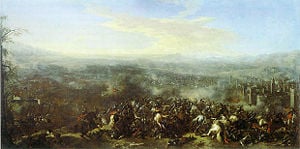
Olivares had backed certain taxation reforms in Spain pending the end of the war, but was blamed for another embarrassing and fruitless war in Italy. The Dutch, who during the Twelve Years' Truce had increasingly made their navy a priority, (which showed its maturing potency at the Battle of Gibraltar 1607), struck a blow against Spanish maritime trade with the capture of the treasure fleet by captain Piet Hein, on which Spain had become dependent after the economic collapse.
Spanish military resources were fully stretched across Europe and at sea. They tried to protect maritime trade against the greatly improved Dutch and French fleets. They were also still occupied with the Ottoman and Barbary pirate threat in the Mediterranean. A Dutch takeover of much of Brazil was reversed by a Spanish-Portuguese expeditions, beginning with admiral Fradique de Toledo's expedition in 1625. Elsewhere the isolated and undermanned Portuguese forts in Africa and the Asia proved particularly vulnerable to Dutch and English raids and takeovers or were simply bypassed as important trading posts.
In 1630, Gustavus Adolphus of Sweden, one of history's most noted commanders, landed in Germany and relieved the port of Stralsund, the last continental stronghold of German forces belligerent to the Emperor. Marching South, Gustavus marched south and won notable victories at Breitenfeld and Lützen, attracting more Protestant support with every step he took. The situation for the Catholics improved with Gustavus's death at Lutzen in 1632, followed by a key victory at Nordlingen in 1634. From a position of strength, the Emperor offered the war-weary German states peace terms in 1635: many accepted, including the two most powerful, Brandenburg and Saxony. Then France entered the equation, and diplomatic calculations were thrown in to confusion.
Cardinal Richelieu of France strongly supported the Dutch and Protestants since the beginning of the war, sending funds and equipment in an attempt to stem Habsburg strength in Europe. Deciding that the recently-signed Peace of Prague was contrary to French designs, he declared war on the Holy Roman Emperor and Spain within months of the peace being signed. In the war that followed, the more experienced Spanish forces scored initial successes. Olivares ordered a lightning campaign into northern France from the Spanish Netherlands, hoping to shatter King Louis XIII's ministers' resolve and topple Richelieu. In the "année de Corbie", 1636, Spanish forces advanced as far south as Corbie, and such was the threat to Paris that the war came close to a conclusion on Spanish terms.
After 1636 Olivares halted the advance, fearful of bankrupting the crown. Hesitation in pressing the advantage home proved fateful; French forces regrouped, pushing the Spanish back towards the border. The Spanish army never again penetrated so far. At the Battle of the Downs in 1639 a Spanish fleet carrying troops was destroyed by the Dutch navy, and the Spanish found themselves unable to supply and reinforce their forces adequately in the Netherlands. The Army of Flanders, which represented the finest of Spanish soldiery and leadership, faced a French assault led by Louis II de Bourbon, Prince de Condé in northern France at Rocroi in 1643. The Spanish, led by Francisco de Melo, were devastated, with most of their infantry slaughtered or captured by French cavalry. The high reputation of the Army of Flanders was broken at Rocroi, and with it, the grandeur of Spain.
The Empire of the last Spanish Habsburgs (1643–1713)
Traditionally, historians mark the Battle of Rocroi (1643) as the end of Spanish dominance in Europe, but the war was not finished. Supported by the French, the Catalans, Neapolitans, and Portuguese revolted against the Spanish in the 1640s. With the Netherlands effectively lost after the Battle of Lens in 1648, the Spanish made peace with the Dutch, recognizing the independent United Provinces in the Peace of Westphalia that ended both the Eighty Years' War and the Thirty Years' War. Retrieved November 11, 2008. War with France continued for eleven more years. Although France suffered from a civil war from 1648–52 the Spanish economy was so exhausted that it was unable to cope with war on so many fronts. Yet the decline of Spanish power in this period has often been overstated. Spain retook Naples in 1648 and Catalonia in 1652, but the war ended at the Battle of the Dunes (1658) where the French army under Viscount Turenne defeated the remnants of the Spanish army of the Netherlands. Spain agreed to the Peace of the Pyrenees in 1659 that ceded to France Roussillon and Artois.
Portugal had rebelled in 1640 under the leadership of John of Braganza, a pretender to the throne. He had received widespread support from the Portuguese people, and Spain—which had to deal with rebellions elsewhere, along with the war against France – was unable to respond adequately. John mounted the throne as King John IV of Portugal and the Spanish and Portuguese co-existed in a de facto state of peace from 1644 to 1657. When John died in 1657, the Spanish attempted to wrest Portugal from his son Alfonso VI of Portugal but were defeated at Ameixial (1663) and Montes Claros (1665), leading to Spain's recognition of Portugal's independence in 1668.
Spain still had a huge overseas empire, but France was now the superpower in Europe and the United Provinces were in the Atlantic.
The Great Plague of Seville (1647-1652) killed up to 25 percent of Seville's population. Sevilla, and indeed the economy of Andalucía, would never recover from so complete a devastation. Altogether Spain was thought to have lost 500,000 people, out of a population of slightly fewer than 10,000,000, or nearly 5 percent of its entire population. Historians reckon the total cost in human lives due to these plagues throughout Spain, throughout the entire seventeenth century, to be a minimum of nearly 1.25 million.[12]
The regency of the young Spanish king Charles II was incompetent in dealing with the War of Devolution that Louis XIV of France prosecuted against the Spanish Netherlands in 1667–68, losing considerable prestige and territory, including the cities of Lille and Charleroi. In the Franco-Dutch War of 1672-1678, Spain lost still more territory when it came to the assistance of its former Dutch enemies, most notably Franche Comté. In the Nine Years' War (1688-1697) Louis once again invaded the Spanish Netherlands. French forces led by the Duke of Luxembourg defeated the Spanish at Fleurus (1690), and subsequently defeated Dutch forces under William III of Orange, who fought on Spain's side. The war ended with most of the Spanish Netherlands under French occupation, including the important cities of Ghent and Luxembourg. The war revealed to Europe how vulnerable and backward the Spanish defenses and bureaucracy were, but the ineffective Spanish Habsburg government took no action to improve them.
The final decades of the seventeenth century saw decay and stagnation in Spain; while the rest of Western Europe went through changes in government and society—the Glorious Revolution in England and the reign of the Sun King in France—Spain remained adrift. The Spanish bureaucracy that had built up around the charismatic, industrious, and intelligent Charles I and Philip II demanded a strong and hardworking monarch; the weakness and lack of interest of Philip III and Philip IV contributed to Spain's decay. Charles II was mentally retarded and impotent. He was therefore childless, and in his final will left his throne to the Bourbon prince Philip of Anjou, rather than to a member of the family that had tormented him throughout his life. This resulted in the War of the Spanish Succession.
The Bourbon Spanish Empire: Reform and Recovery (1713–1806)
Under the Treaties of Utrecht (April 11, 1713), the European powers decided what the fate of Spain would be, in terms of the continental balance of power. The new Bourbon king Philip V retained the Spanish overseas empire, but ceded the Spanish Netherlands, Naples, Milan, and Sardinia to Austria; Sicily and parts of Milan to Duchy of Savoy; and Gibraltar and Minorca to the Kingdom of Great Britain.
The disastrous performance in the War of the Quadruple Alliance, 1718–1720, exposed the level of Spain's weakness. Philip V granted the British the exclusive right to slave trading in Spanish America for 30 years, the so-called asiento, as well as licensed voyages to ports in Spanish colonial dominions, openings. Spain's economic and demographic recovery had begun slowly in the last decades of the Habsburg reign, as was evident from the growth of its trading convoys and much more rapid growth of illicit trade during the period, though this growth was slower than in her northern rivals who had gained increasing illicit access to her empire's markets. Critically, this recovery was not translated into institutional improvement because of the incompetent leadership of the unfortunate last Habsburg. This legacy of neglect was reflected in the early years of Bourbon rule in which the military was ill-advisedly pitched into battle against the Quadruple alliance. The poor performance of the demoralized Spanish military is well illustrated by the Battle of Cape Passaro, when a Spanish fleet was captured by the British. The British navy found the captured ships in such a rotten state that their best use was to be broken up. Following the war the new Bourbon monarchy would take a much more cautious approach to international relations, built upon a family alliance with Bourbon France, and continuing to follow a program of institutional renewal.
The Bourbon monarchy brought with it a repertory of Bourbon mercantilist ideas based on a centralized state. In America, this was put into effect slowly at first but with increasing momentum during the century. The Spanish Bourbons' broadest intentions were to break the power of the entrenched aristocracy of the Criollos (locally born colonials of European descent), and, eventually, loosen the territorial control of the Society of Jesus over the virtually independent theocracies of Guarani Missions. After the Jesuits were expelled from Spanish America in 1767. In addition to the established consulados(consulates) of Mexico City and Lima, firmly in the control of local landowners, a new rival consulado was set up at Vera Cruz.
Philip's government set up a ministry of the Navy and the Indies (1714) and created first a Honduras Company (1714), a Caracas company, the Guipuzcoana Company, (1728) and—the most successful one—a Havana Company (1740). In 1717–1718 the structures for governing the Indies, the Consejo de Indias and the Casa de Contratación that governed investments in the cumbersome escorted fleets were transferred from Seville to Cádiz, which became the one port for all Indies trading. Individual sailings at regular intervals were slow to displace the old habit of armed convoys, but by the 1760s there were regular packet ships plying the Atlantic between Cádiz and Havana and Puerto Rico, and at longer intervals to the Río de la Plata, where an additional viceroyalty was created in 1776. The contraband trade that was the lifeblood of the Habsburg empire declined in proportion to registered shipping (a shipping registry having been established in 1735).
Two upheavals created unease within Spanish America and at the same time demonstrated the renewed resiliency of the reformed system: the Tupac Amaru uprising in Peru in 1780 and the [[Revolt of the Comuneros (New Granada)|rebellion of the comuneros (citizen uprising) of New Granada, both in part reactions to tighter, more efficient control.
Eighteenth century prosperity
The eighteenth century was a century of prosperity for the overseas Spanish Empire as trade within grew steadily, particularly in the second half of the century, under the Bourbon reforms. Spain's crucial victory in the Battle of Cartagena against an extraordinary British fleet, in the Caribbean port of Cartagena de Indias, one of a number of successful battles, helped it secure Spain's dominance of the Americas until the nineteenth century.
Rapid shipping growth from the mid-1740s until the Seven Years' War (1756–1763), reflecting in part the success of the Bourbons in bringing illicit trade under control. With the loosening of trade controls after the Seven Years War, shipping trade within the empire once again began to expand, reaching an extraordinary rate of growth in the 1780s.
The ending of Cádiz's trade monopoly with America brought about a rebirth of Spanish manufactures. Most notable was the rapidly growing textile industry of Catalonia which by the mid-1780s saw the first signs of industrialization. This saw the emergence of a small, politically-active commercial class in Barcelona. Though the scale of such industry was very small compared to the vast industry in Lancashire, it was growing rapidly and was to become a major center of such industry in the Mediterranean in the mid nineteenth century. Though one must not exaggerate such small, scattered examples of local modernity, especially when seen in the light of the vast developments then taking place to the north, especially Britain, they do disprove the notion of economic stasis. Most of the improvement was in and around some major coastal cities and the major islands such as Cuba, with its plantations, and a renewed growth of precious metals mining in America. On the other hand most of rural Spain and its empire, where the great bulk of the population lived, lived in backward conditions, that were reinforced by old customs and served by poor roads. Agricultural productivity remained low despite efforts to introduce new techniques to an uninterested, exploited peasant and landless laboring class. Governments were inconsistent in their policies. Even with the substantial improvements of the eighteenth century, Spain was still an economic backwater. Under the mercantile trading arrangements it had difficulty in providing the goods being demanded by the strongly growing markets of its empire, and providing adequate outlets for the return trade, leading to rising tensions with its colonial elites.
The Bourbon institutional reforms were to bear some fruit militarily when Spanish forces easily retook Naples and Sicily from the Austrians in 1734 (War of the Polish Succession) and thwarted British campaigns attempting to seize the strategic cities of Cartagena de Indias and Cuba during the War of Jenkins' Ear (1739–1742). Moreover, though Spain lost territories to greatly improved and successful amphibious British forces towards the end of the Seven Years' War (1756–1763), she was to recover these losses and seize the British naval base in the Bahamas during the American Revolutionary War (1775–1783).
The Amazon basin and some large adjoining regions had been considered Spanish territory since the Treaty of Torsedillas and explorations such as that by Francisco de Orellana. The area was occupied by Portuguese colonists in Brazil, as Bandeirantes gradually extended their slaving and prospecting activities throughout much of the basin in the 17th and 18th centuries. Meanwhile the Spanish were barred by their laws from slaving of indigenous people, leaving them without a commercial interest deep in the interior of the basin.[13] These groups had the advantage of remote geography and river access from the mouth of the Amazon River, which was in Portuguese territory, making it impossible for the Spanish authorities to control them. One famous attack upon a Spanish mission in 1628 resulted in the enslavement of 60,000 indigenous people.[14] In fact as time passed they were used as a self funding occupation force by the Portuguese authorities in what was effectively a low level war of territorial conquest. Finally the reality of the situation was recognized with the transfer of sovereignty over the much of the basin and surrounding areas to Portugal in the Treaty of Madrid (1750). This settlement led to the Guarani War of 1756.
The California mission planning was begun in 1769. The Nootka Crisis (1789–1791) involved a dispute between Spain and Great Britain about the British settlement in Oregon to British Columbia. In 1791 the king of Spain gave Alessandro Malaspina an order to search for a Northwest Passage.
The Spanish empire had still not returned to first rate power status, but it had recovered considerably from the dark days at the beginning of the eighteenth century when it was totally at the mercy of other powers' political deals. The relatively peaceful century under the new monarchy had allowed it to rebuild and start the long process of modernizing its institutions and economy. The demographic decline of the seventeenth century had been reversed. It was a middle ranking power with great power pretensions that could not be ignored. But time was to be against it. The growth of trade and wealth in the colonies caused increasing political tensions as frustration grew with the improving but still restrictive trade with Spain. Malaspina's recommendation to turn the empire into a looser confederation to help improve governance and trade so as to quell the growing political tensions between the élites of the empire's periphery and centre was suppressed by a monarchy afraid of losing control. All was to be swept away by the tumult that was to overtake Europe at the turn of the century with the French Revolutionary and Napoleonic Wars.
Twilight of the Global Empire (1806–1898)
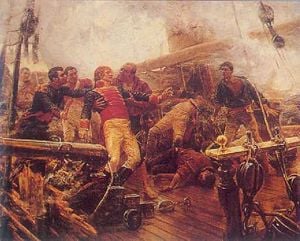
The first major territory Spain was to lose in the nineteenth century was the vast and wild Louisiana Territory, which stretched north to Canada and was ceded by France in 1763. The French, under Napoleon, took back possession as part of the Treaty of San Ildefonso in 1800 and sold it to the United States (Louisiana Purchase, 1803).
The destruction of the main Spanish fleet, under French command, at the Battle of Trafalgar (1805) undermined Spain's ability to defend and hold on to its empire. The later intrusion of Napoleonic forces into Spain in 1808 (see Peninsular War) cut off effective connection with the empire. But it was internal tensions that ultimately ended the empire in America.
Napoleon's sale in 1803 of the Louisiana Territory to the United States was to cause border disputes between the United States and Spain that, with rebellions in West Florida (1810) and in the remainder of Louisiana at the mouth of the Mississippi, led to their eventual cession to the United States, along with the sale of all of Florida, in the Adams–Onís Treaty (1819).

In 1808 the Spanish king was tricked and Spain was taken over by Napoleon without firing a shot, but the brutal French provoked a popular uprising from the Spanish people and the grinding guerrilla warfare, which Napoleon dubbed his "ulcer," the Peninsular War, (famously depicted by the painter Goya) ensued, followed by a power vacuum lasting up to a decade and turmoil for several decades, civil wars on succession disputes, a republic, and finally a liberal democracy. Spain lost all the colonial possessions in the first third of the century, except for Cuba, Puerto Rico and, isolated on the far side of the globe, the Philippines, Guam and nearby Pacific islands, as well as Spanish Sahara, parts of Morocco, and Spanish Guinea.
The wars of independence in Spanish America were triggered by another failed British attempt to seize Spanish American territory, this time in the Viceroyalty of the Río de la Plata in 1806. The viceroy retreated hastily to the hills when defeated by a small British force. However when the Criollos militias and colonial army thrashed the now reinforced British force in 1807 and, with the example of the North American revolutionaries very much in their minds, they quickly set about the business of winning their own independence and inspiring independence movements elsewhere in America. A long period of wars began which led to the independence of Paraguay (1811) and Uruguay (1815 but subsequently ruled by Brazil until 1828). José de San Martín campaigned for freedom in Argentina (1816), Chile (1818) and Peru (1821). Further north Simon Bolivar led forces that won independence for the area that is currently Venezuela, Colombia (included Panama until 1903), Ecuador, and Bolivia by 1825. In 1810 a free thinking priest, Miguel Hidalgo y Costilla, declared Mexican independence, which was won by 1821. Central America declared its independence in 1821 and was joined to Mexico for a brief time (1822–1823). Santo Domingo likewise declared independence in 1821 and began negotiating for inclusion in Bolivar's Republic of Gran Colombia, but was quickly occupied by Haiti, which ruled it until an 1844 revolution. Thus only Cuba and Puerto Rico remained in Spanish hands in the New World.
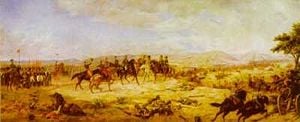
In devastated Spain the post-Napoleonic era created a political vacuum, broke apart any traditional consensus on sovereignty, fragmented the country politically and regionally and unleashed wars and disputes between progressives, liberals and conservatives. The instability inhibited Spain's development, which had started fitfully gathering pace in the previous century. A brief period of improvement occurred in the 1870s when the capable Alfonso XII of Spain and his thoughtful ministers succeeded in restoring some vigor to Spanish politics and prestige, but this was cut short by Alfonso's early death.
An increasing level of nationalist, anti-colonial uprisings in various colonies culminated with the Spanish–American War of 1898, fought primarily over Cuba. Military defeat was followed by the independence of Cuba and the cession, for US$20 million, of Puerto Rico, the Philippines, and Guam to the United States. On June 2, 1899,[15] the last Spanish garrison in the Philippines, located in Baler, Aurora, was pulled out, effectively ending nearly 400 years of Spanish hegemony in this archipelago. Her American and Asian presence ended, Spain then sold her Pacific Ocean possessions to Germany in 1899, retaining only her African territories.
Territories in Africa (1898–1975)
In 1481, the papal Bull Æterni regis had granted all land south of the Canary Islands to Portugal. Only this archipelago and the cities of Sidi Ifni (1476–1524), known then as "Santa Cruz de Mar Pequeña," Melilla (conquered by Pedro de Estopiñán in 1497), Villa Cisneros (founded in 1502 in current Western Sahara), Mazalquivir (1505), Peñón de Vélez de la Gomera (1508), Oran (1509–1790), Algiers (1510–1529), Bugia (1510–1554), Tripoli (1511–1551), Tunis (1535–1569) and Ceuta (ceded by Portugal in 1668) remained as Spanish territory in Africa.
In 1778, Fernando Poo (now Bioko) Island, adjacent islets, and commercial rights to the mainland between the Niger and Ogooué Rivers were ceded to Spain by the Portuguese in exchange for territory in South America (Treaty of El Pardo (1778)). In the 19th century, some Spanish explorers and missionaries would cross this zone, among them Manuel de Iradier.
In 1848, Spanish troops conquered the Islas Chafarinas.
In 1860, after the Tetuan War, Morocco ceded Sidi Ifni to Spain as a part of the Treaty of Tangiers. The following decades of Franco-Spanish collaboration resulted in the establishment and extension of Spanish protectorates south of the city, and Spanish influence obtained international recognition in the Berlin Conference of 1884: Spain administered Sidi Ifni and Western Sahara jointly. Spain claimed a protectorate over the coast of Guinea from Cape Bojador to Cap Blanc, too. Río Muni became a protectorate in 1885 and a colony in 1900. Conflicting claims to the Guinea mainland were settled in 1900 by the Treaty of Paris.
Following a brief war in 1893 Spain expanded her influence south from Melilla.
In 1911, Morocco was divided between the French and Spanish. The Rif Berbers rebelled led by Abdelkrim, a former officer for the Spanish administration. The Battle of Annual (1921) was a sudden, grave, and almost fatal, military defeat suffered by the Spanish army against Moroccan insurgents. The rebellion exposed the utter corruption and incompetence of the military and destabilized the Spanish government, leading to dictatorship. A campaign in conjunction with the French suppressed the Rif rebels by 1925 but at a terrible cost to both sides. In 1923, Tangier was declared an international city under French–Spanish–British (and later Italian) joint administration. The African army, led by a veteran of the Moroccan campaign, Francisco Franco, started the Spanish Civil War (1936–1939). Between 1926 and 1959, Bioko and Rio Muni were united as the colony of Spanish Guinea. During the Second World War the Vichy French presence in Tangier was overcome by that of Francoist Spain.
Spain lacked the wealth and the interest to develop an extensive economic infrastructure in her African colonies during the first half of the twentieth century. However, through a paternalistic system, particularly on Bioko Island, Spain developed large cocoa plantations for which thousands of Nigerian workers were imported as laborers. The Spanish also helped Equatorial Guinea achieve one of the continent's highest literacy rates and developed a good network of health care facilities.
In 1956, when French Morocco became independent, Spain surrendered Spanish Morocco to the new nation, but retained control of Sidi Ifni, Tarfaya region and Spanish Sahara. Moroccan Sultan (later King) Mohammed V was interested in these territories and invaded Spanish Sahara in 1957 (The Ifni War, or, in Spain, the Forgotten War, la Guerra Olvidada). In 1958, Spain ceded Tarfaya to Mohammed V and joined the previously separate districts of Saguia el-Hamra (in the north) and Río de Oro (in the south) to form the province of Spanish Sahara.
In 1959, the Spanish territory on the Gulf of Guinea was established with status similar to the provinces of metropolitan Spain. As the Spanish Equatorial Region, it was ruled by a governor general exercising military and civilian powers. The first local elections were held in 1959, and the first Equatoguinean representatives were seated in the Spanish parliament. Under the Basic Law of December 1963, limited autonomy was authorized under a joint legislative body for the territory's two provinces. The name of the country was changed to Equatorial Guinea.
In March 1968, under pressure from Equatoguinean nationalists and the United Nations, Spain announced that it would grant independence to Equatorial Guinea. At independence in 1968, Equatorial Guinea had one of the highest per capita incomes in Africa. In 1969, under international pressure, Spain returned Sidi Ifni to Morocco. Spanish control of Spanish Sahara endured until the 1975 Green March prompted a withdrawal. The future of this former Spanish colony remains uncertain.
The Canary Islands and the cities in the African mainland are considered an equal part of Spain and the European Union but have a different tax system without Value Added Tax.
Morocco still says they claim Ceuta, Melilla, and plazas de soberanía even though they are internationally recognized as administrative divisions of Spain (despite Plazas de Soberania which is a territory of Spain). Isla Perejil ("night")) was occupied on July 11, 2002 by Moroccan Gendarmerie and troops, who were evicted peacefully by Spanish naval forces.
Legacy
The Spanish language and the Roman Catholic church were brought to America and to the Spanish East Indies (Federated States of Micronesia, Guam, Marianas, Palau, and the Philippines) by Spanish colonization which began in the 15th century. It also played a crucial part in sustaining the Catholic Church as the leading Christian denomination in Europe when it was under extreme pressure.
The long colonial period in Hispanic America resulted in a mixing of peoples. Most Hispanics in the Americas have mixed American Indian and European ancestry, while a substantial proportion also have African ancestry. The only exceptions may be Uruguay and possibly Argentina, which experienced heavy European immigration in the post colonial period.
In concert with the Portuguese empire, the Spanish empire laid the foundations of a truly global trade by opening up the great trans-oceanic trade routes. The Spanish dollar became the world's first global currency.
One of the features of this trade was the exchange of many domesticated plants and animals between the Old World and the New World. Some that were introduced to America included wheat, barley, onions, apples, watermelons, cattle, sheep, pigs, horses, and donkeys. The Old World received from America such things as maize, potatoes, sweet potatoes, capsicum, chili peppers, tomatoes, peanuts, tobacco, and turkeys. The result of these exchanges was to significantly improve the agricultural potential of America, Europe and Asia as well as increase the power available for heavy work and transportation in the Americas.
There were also cultural influences, which can be seen in everything from architecture, food, music, art and law, from Chile to the United States. The complex origins and contacts of different peoples resulted in cultural influences coming together in the widely varied and unique forms so evident today in the former colonial areas.
To a very considerable extent modern International law has its roots in issues first encountered with the experience of Spanish colonial expansion. Even modern notions of human rights were first defended in the often bitter debates and political controversies caused by the encounter with formerly unknown peoples in the Americas. Modern disdain for imperialism also has some of its roots in Spanish critiques of imperialism - theoretically, in terms of its legitimacy, and due to experience, in the harm that it caused.
See also
Notes
- ↑ Jeff Grabmeier, 2003. When Europeans were slaves: Research suggests white slavery was much more common than previously believed. introducing book by Robert C. Davis, Christian Slaves, Muslim Masters: White Slavery in the Mediterranean, the Barbary Coast, and Italy, 1500-1800. Ohio State University Research News. Retrieved November 16, 2008.
- ↑ David A. Koplow, 2003. Smallpox The Fight to Eradicate a Global Scourge, chapter one. Berkeley, CA: University of California Press. ISBN 9780520237322. Retrieved November 16, 2008.
- ↑ Laws of Burgos, 1512-1513 Dallas: Southern Methodist University. Retrieved November 16, 2008.
- ↑ James Axtell, 1991. The Columbian Mosaic in Colonial America. Humanities 12(5):12-18. Retrieved November 16, 2008.
- ↑ Sandra Lach Arlinghaus, Timeline, Life Span of Suleiman The Magnificent, 1494-1566. Ann Arbor, MI: University of Michigan. Retrieved November 16, 2008.
- ↑ "whose religion, his religion" meaning that the people follow the religion of the prince or ruler.
- ↑ John Finnemore, (1912) Barbary Rovers. online, The Early Corsairs—II. The Baldwin Project - Yesterday's Classics. Retrieved November 16, 2008.
- ↑ Christon Archer, et al. 2002. World History of Warfare. (Lincoln, NE: University of Nebraska Press. ISBN 9780803244238), 251.
- ↑ Fernand Braudel and Siân Reynolds, (trans.) 1992. Civilization and Capitalism, 15th-18th Century: The Perspective of the World. (Berkeley, CA: University of California Press. ISBN 9780520081161), 32.
- ↑ Spain under the Habsburgs > The reign of Philip III. Encyclopedia Britannica. Retrieved November 16, 2008.
- ↑ J. Brown and J.H. Elliott. 1980. A palace for a king. The Buen Retiro and the Court of Philip IV. (New Haven, CT: Yale University Press. ISBN 9780300025071), 190.
- ↑ Stanley G. Payne, The Seventeenth-Century Decline. Chapter Fifteen, A History of Spain and Portugal. Conway, AR: University of Central Arkansas, The Library of Iberian Resources Online. Retrieved November 16, 2008.
- ↑ The Laws of Burgos (1512) and the New Laws (1542) had been intended to protect the interests of indigenous people. While in spirit they were often abused, as through forced exploitative labor of locals, they did prevent widespread formal enslavement of indigenous people in Spanish territories. Renegade slavers, operating illegally in Spanish territory, did so as agents of the Portuguese slave markets in Brazil.
- ↑ An early bandeira in 1628, led by Antônio Raposo Tavares (1598 – 1658), composed of 2000 allied Indians, 900 Mamluks (Mestizos) and 69 white Paulistanos, to find precious metals and gemstones and/or to capture Indians for slavery. This expedition alone was responsible for the destruction of most of the Jesuit missions of Spanish Guairá and the enslavement of over 60,000 indigenous people, including Guaranis. In response the missions that followed were militarized.
- ↑ Miguel Hernandez, Lieutenant Saturnino Martín Cerezo surrender after 337 days of siege. Spanish American War Centennial Website. Retrieved November 16, 2008.
ReferencesISBN links support NWE through referral fees
- Archer, Christon et al. 2002. World History of Warfare. Lincoln, NE: University of Nebraska Press. ISBN 9780803244238.
- Armstrong, Edward. 1973. The emperor Charles V. Freeport, NY: Books for Libraries. ISBN 9780518190127.
- Axtell, James, 1991. "The Columbian Mosaic in Colonial America." Humanities 12(5):12-18.
- Black, Jeremy. 1996. The Cambridge illustrated atlas of warfare: Renaissance to revolution. Cambridge, UK: Cambridge University Press. ISBN 0521470331.
- Braudel, Fernand, and Siân Reynolds trans. 1972. The Mediterranean and the Mediterranean World in the Age of Philip II. New York, NY: Harper & Row. ISBN 0060905662.
- Braudel, Fernand, and Siân Reynolds, trans. 1992. Civilization and Capitalism, 15th-18th Century: The Perspective of the World. Berkeley, CA: University of California Press. ISBN 9780520081161.
- Brown, J., and J.H. Elliott. 1980. A palace for a king. The Buen Retiro and the Court of Philip IV. New Haven, CT: Yale University Press. ISBN 9780300025071.
- Brown, Jonathan. 1998. Painting in Spain : 1500–1700. New Haven, CT: Yale University Press. ISBN 0300064721.
- Davis, Robert. Christian Slaves, Muslim Masters: White Slavery in the Mediterranean, the Barbary Coast, and Italy, 1500-1800. Palgrave Macmillan, 2003. ISBN 1403945519.
- Dominguez Ortiz, Antonio. 1971. The golden age of Spain, 1516-1659. Oxford, UK: Oxford University Press. ISBN 0297004050.
- Edwards, John. 2000. The Spain of the Catholic Monarchs, 1474-1520. New York, NY: Blackwell. ISBN 0631161651.
- Finnemore, John. Barbary Rovers. 1912 online
- Harman, Alec. 1969. Late Renaissance and Baroque music. New York, NY: Schocken Books.
- Kamen, Henry. 1998. Philip of Spain. New Haven, CT; London, UK: Yale University Press. ISBN 0300078005.
- Kamen, Henry. 2003. Empire: How Spain Became a World Power, 1492-1763. New York, NY: HarperCollins. ISBN 0060932643.
- Kamen, Henry. 2005. Spain 1469-1714. A Society of Conflict, 3rd ed. London, UK; New York, NY: Pearson Longman. ISBN 0582784646.
- Koplow, David A. Smallpox: The Fight to Eradicate a Global Scourge. University of California Press, 2004. ISBN 0520242203.
- Parker, Geoffrey. 1972. The Army of Flanders and the Spanish road, 1567-1659; the logistics of Spanish victory and defeat in the Low Countries' Wars. Cambridge, UK: Cambridge University Press. ISBN 0521084628.
- Parker, Geoffrey. 1977. The Dutch revolt. Cambridge, UK: Cambridge University Press. ISBN 080141136X.
- Parker, Geoffrey. 1978. Philip II. Boston, MA: Little, Brown. ISBN 0316690805.
- Parker, Geoffrey. 1997. The general crisis of the seventeenth century. New York, NY: Routledge. ISBN 0415165180.
- Parker, Geoffrey. 1997. The Thirty Years' War, 2nd ed. New York, NY: Routledge. ISBN 0415128838.
- Stradling, R.A. 1988. Philip IV and the government of Spain. Cambridge, UK: Cambridge University Press. ISBN 0521323339.
- Thomas, Hugh. 1997. The Slave Trade; The History of the Atlantic Slave Trade 1440-1870. London, UK: Papermac. ISBN 0333731476.
- Thomas, Hugh. 2004. Rivers of Gold: The Rise of the Spanish Empire 1490-1522. Weidenfeld & Nicolson. ISBN 0297645633.
- Wright, Esmond, ed. 1984. History of the World, Part II: The last five hundred years, 3rd ed. New York, NY: Hamlyn Publishing. ISBN 0517436442.
External links
All links retrieved February 7, 2023.
Credits
New World Encyclopedia writers and editors rewrote and completed the Wikipedia article in accordance with New World Encyclopedia standards. This article abides by terms of the Creative Commons CC-by-sa 3.0 License (CC-by-sa), which may be used and disseminated with proper attribution. Credit is due under the terms of this license that can reference both the New World Encyclopedia contributors and the selfless volunteer contributors of the Wikimedia Foundation. To cite this article click here for a list of acceptable citing formats.The history of earlier contributions by wikipedians is accessible to researchers here:
The history of this article since it was imported to New World Encyclopedia:
Note: Some restrictions may apply to use of individual images which are separately licensed.

